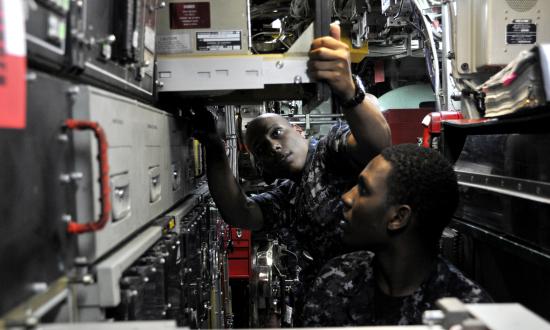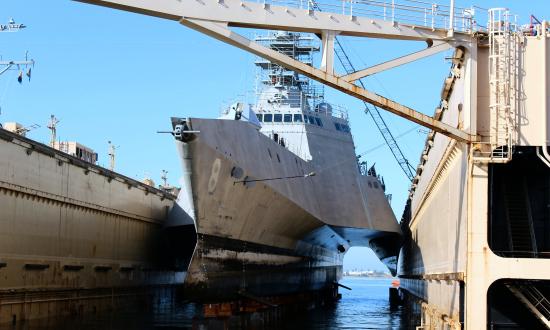Lieutenant Commander George Packham’s terse announcement echoed across the ship less than an hour before midnight on 6 October 1943. His calm delivery belied the deadly situation it portended: “Stand by, we’re going to get hit by a torpedo.”1
This message, heard all too commonly in the hornets’ nest known as the “slot” off Vella Lavella in the Solomon Islands, set in motion an incredible sequence of events. The blast that followed shook the USS Selfridge (DD-357) to her core, resulted in the loss of 49 sailors, and severed nearly 100 feet from the bow of the ship.
In the ensuing hours and days, a herculean damage control effort by the determined crew coalesced with a network of expeditionary shore-based repair facilities and sea-based tenders to aid the Selfridge in her fight for survival. This intricate support web, which stretched across the South Pacific to the coast of California, allowed the battle-damaged destroyer, and many others like her, to return to combat before the end of the war.2 The Selfridge sailed back into the fray less than nine months after the Japanese torpedo found its mark.
The astonishing tenacity of the Selfridge and the U.S. Navy’s World War II repair network provide historical evidence that a navy’s strength lies not only in the number of hulls it possesses, but also in its ability to keep those ships “in the fight” once combat operations—and battle damage—commence.
Nearly eight decades later, fundamental observations drawn from the creation and placement of expeditionary repair facilities during World War II remain relevant. Specifically, the ability to identify and prepare ideal geographic locations for expeditionary repair, efficiently leverage both shore- and sea-based assets, anticipate material and manning needs, and maximize the use of emerging technologies will define success or failure in a peer-power naval war.
Great Power Competition Requires Repair Resiliency
The current great power competition and its heightened potential for military confrontations should spur renewed examination of the United States’ last great power naval conflict. Novel concepts that allowed the Navy to expand its reach and increased its battle damage repair resiliency in World War II must reemerge for modern-day contemplation. While a numerically larger navy has been the primary focus of recent discussions on countering a revisionist China, Navy leaders should ensure that a fixation on hull count does not distract from the pivotal importance of efficient battle damage ship repair in forward areas. The realities of a 7,500-mile South China Sea time-distance conundrum are much the same today as they were 80 years ago, and they ordain expeditionary ship repair, and the resiliency it provides, as a force multiplier.
Modern competitors’ advanced surveillance and reconnaissance systems and precision strike weapons presage frequent and significant battle damage during any future large-scale conflict. For the Navy, this dictates a strategy of distributed and mobile ship repair assets. Expeditionary battle damage repair assets diffuse capability across a large theater of operation, increasing the assets’ efficiency and survivability and complicating enemy targeting.
The advent and proliferation of “carrier killer” missiles, such as China’s much-heralded DF-21D, should cause concern, but sinking a well-designed warship operated by a professionally trained crew remains difficult. The four weeks of consistent battering the super carrier ex-USS America endured in a 2005 sinking exercise speaks to the resiliency of modern vessels. This is a paradox of a future great power conflict: Technology will facilitate the aggressive targeting of naval vessels with high numbers of precision-guided weapons and thus increase rates of battle damage, but technology also will make the targeted ships more survivable once struck. This contradiction speaks to the necessity of efficient repair in forward areas.
Recent events, however, demonstrate a proclivity to return Navy vessels stateside to repair damage incurred across the globe. This decades-old pattern has endured since an Iranian mine struck the USS Samuel B. Roberts (FFG-58) in 1988: Recovery crews load the damaged vessel on a foreign-flagged heavy-lift ship, it embarks on a several month journey back to a stateside shipyard, and then it undergoes repairs that often take years. This process was followed for damage sustained from the terrorist attack on the USS Cole (DDG-67) in 2000 and for repairs to the USS Fitzgerald (DDG-62) following a collision at sea in 2017.3 Of note, the dearth of U.S.-flagged float-on/float-off heavy-lift ships requires negotiation with foreign entities to facilitate damaged ship movement. This method has proven suitable for limited and widely spaced peacetime incidents, but it would collapse in the event of a major conflict with higher rates of battle damage and increased geopolitical tensions.
Contemporary strategic documents allude to requirements for efficient battle damage repair in forward areas, although not with the detail or urgency necessary to ensure the Navy’s ability to sustain major wartime operations across the globe. The 2018 National Defense Strategy highlights the importance of “resilient and agile logistics,” including “non-commercially dependent logistics and maintenance” options.4 The triservice maritime strategy Advantage at Sea states that “logistics and auxiliary ships will surge to establish refueling, rearming, resupply, revive, and repair points,” but it does not elaborate on the method for accomplishing this goal in the likely operating environment or with the currently available force structure.5 With this in mind, lessons from past Navy success in battle damage repair in forward areas should inform future requirements and actions.
Historical Insights For Damage Repair
The repair facilities at New Caledonia that supported the Selfridge, along with hundreds of other shore- and sea-based forward repair assets, stand as innovative examples of vital ship repair capabilities that sustained U.S. operations against a peer adversary during World War II. In particular, the naval buildup at Ulithi Atoll in the Caroline Islands remains an informative study in expeditionary ship repair and support facilities.
Ulithi, located 370 miles southwest of Guam, underwent a massive conversion in 1944, transforming from a desolate South Pacific island into a fully functioning repair facility for naval vessels. In less than three months, a concerted construction effort created a 3,500-foot runway, pontoon piers, floating dry docks, a hospital, and an anchorage for more than 600 ships.6 While all future forward repair capabilities do not need to match the robust attributes developed at Ulithi, planners can use this extreme case to build a diverse array of expeditionary options in the current global environment.
First among the lessons from the past, the Navy will require strategically placed expeditionary shore-based repair facilities at the edge of its competitors’ lethality rings. A portion of these forward repair locations should allow for rapid geographic adjustment based on the larger ebb and flow of combat operations. As Fleet Admiral Ernest King succinctly stated in a December 1945 report to the Secretary of the Navy when referring to expeditionary bases in the Pacific, “A base to supply or repair a fleet five thousand miles closer to the enemy multiplies the power which can be maintained constantly against him and greatly lessens the problems of supply and repair.”7
Local government approval for shore-based repair locations should be obtained, or at least considered, as a requirement for potential positioning. When he made an urgent request less than two weeks after Pearl Harbor, Admiral King could rely on immediate approval from the Free French government for an advanced supply base in Bora Bora.8 The geopolitics of a 21st-century peer conflict may inhibit approval of similar requests. Indeed, current tensions across the globe foretell the complexity and delicacy of this diplomatic undertaking in peacetime and foreshadow its difficulty in war.
Second, successful expeditionary repair operations will require a substantial fleet of tenders to support repair in austere environments. In the wartime years following the attack on Pearl Harbor, the Navy added 16 types of fleet auxiliary vessels, which encompassed part of the 860 auxiliary vessel increase seen during World War II.9 The Navy’s most recent shipbuilding plan calls for the construction of nine T-ATS-class hulls, which will serve as its towing, salvage, and rescue ship capability over the next 30 years.10 Two other ship classes, the expeditionary transport dock (ESD) and expeditionary sea base (ESB), could support forward ship-repair capabilities with minor modifications. The T-ATS support vessels, along with the drafting of other suitable platforms such as the ESB, could again create a symbiotic relationship with expeditionary shore-based repair facilities, leveraging the advantages of each based on the existing threat level, repair requirements, and asset availability.
Third, mobilization plans must account for immense material and labor requirements, along with the means to transport these items and individuals expeditiously into theater. Germane factors include airfield access to accommodate supply shipments; a ready source of trained artisans, engineers, and laborers; and sufficient protection from threats to the repair capabilities—all daunting tasks. Nearly 20 percent of total U.S. Navy personnel in World War II were assigned to advanced base support operations—more than half a million individuals.11 Already existing shipyard labor deficiencies augur the potential difficulty of generating an additional large pool of qualified labor. Planners must create a realistic plan to rapidly assemble the necessary workforce.
Properly leveraged, modern technological advances can elevate expeditionary repair capabilities even beyond their impressive historical apex. Additive manufacturing, shipbuilding robotics, and drone deliveries of vital repair parts have the potential to transform battle damage repair. As these and other technologies continue to mature, they could mitigate many of the most difficult problems vexing forward ship repair, including the requirement to stock countless low utilization parts and the difficulty of mobilizing qualified labor pools.
Appropriate planning and implementation with consideration to these recommendations, along with the repair capability network they produce, will yield one of three advantageous results: facilitate a damaged ship’s prompt return to combat, enable her to sail to an additional location for follow-on repair, or prescribe the salvaging of vital parts that will enable the rapid return of other ships to battle. Any of these outcomes will increase Navy resiliency.
A Lesson Learned
A Persian proverb states, “History is a mirror of the past and a lesson for the future.” The enduring myth that the next war will be settled quickly, or an overconfidence in one’s ability to operate without incurring battle damage, cannot misguide contemporary actions or blind the Navy to lessons from the past. The United States must focus not only on building a larger navy to face a changed world, but also on taking the steps necessary to ensure damaged ships can be returned to battle as quickly as possible. It will require a colossal effort on many fronts, but history already has presented evidence of its worth.
1. Julie McDonald, “Navy Seaman Recalls War in the Pacific,” The Daily Chronicle, 28 May 2007.
2. Bureau of Ships, Navy Department, Structural Repairs in Forward Areas During World War II (December 1949).
3. Rich Abott, “Fitzgerald Leaves Repair Year Three Years After Collision,” Defense Daily, 15 June 2020.
4. Department of Defense, “Summary of the 2018 National Defense Strategy of the United States of America,” 7.
5. Department of Defense, Advantage at Sea: Prevailing with Integrated All-Domain Power (Washington, DC: December 2020), 14.
6. Department of the Navy Bureau of Yards and Docks, Building the Navy’s Bases in World War II: History of the Bureau of Yards and Docks and the Civil Engineer Corps, 1940–1946, ch. 27, “Bases in the Central Pacific” (Washington, DC: Department of the Navy, 1947).
7. FADM Ernest J. King, USN, Third and Final Report to the Secretary of the Navy, ch. 3, “Logistics and Bases–Pacific,” 8 December 1945, 199.
8. Bureau of Naval Personnel, The Logistics of Advance Bases (Washington, DC: 1947), 38.
9. Ralph K. James, “U.S. Fleet Maintenance and Battle-Damage Repairs in the Pacific during World War II,” Naval Engineers Journal 63, no. 4 (November 1951): 777.
10. Office of the Chief of Naval Operations, Report to Congress on the Annual Long-Range Plan for Construction of Naval Vessels (9 December 2020), 6.
11. King, Third and Final Report to the Secretary of the Navy, 199.










